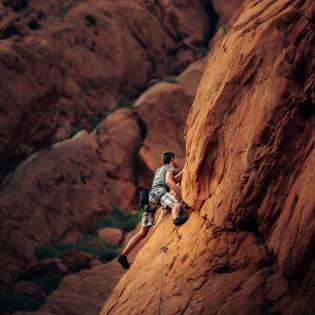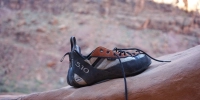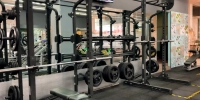Breaking In Climbing Shoes: How Long Does It Take And What To Expect

Buying new climbing shoes can be very exciting, specifically, the moment you actually have them and go climbing in them for the first time. As exciting as this is for many climbers, it is also accompanied by one of the worst aspects of new climbing shoes - the break in period.
This break in period is something almost all climbing shoes will go through. Some shoes will have a more drastic change to them, while others will have little to no change.
If you want to learn what the break in period of climbing shoes is, and how to make it easier on your feet, continue reading. We are going to cover this subject and break it down into easy to digest sections.
- What Does It Mean To Break In Climbing Shoes?
- Why Do I Need To Know About Breaking In Climbing Shoes?
- What Causes Climbing Shoes To Break In?
- How Much Do Climbing Shoes Break In And Stretch?
- How Long Does It Take To Break In Climbing Shoes?
- Can Synthetic Climbing Shoes Stretch?
- How To Break In Climbing Shoes: 3 Simple Steps
- Step 1: Get The Right Size
- Step 2: Use Plastic Bags And Other Break In Methods
- Step 3: Start Climbing, Repeat Step 2 If Necessary
- Methods For Stretching And Breaking In Climbing Shoes
- Climb In Them In Short Increments
- Use Your Shoes On Easy Climbs
- Put Them On At The Bottom Of The Route
- The Sock Method & Wearing Them At Home
- The Plastic Bag Method
- The Pre-Heat Method
- The Hot Shower Method
- The Freezer Method
- Massage The Upper And Bend The Shoe
- How To Break In Aggressive Climbing Shoes
- Frequently Asked Questions
- How Long Does It Take To Break In Aggressive Climbing Shoes?
- Can I Accelerate The Break-in Process Of Aggressive Shoes?
- Will Breaking In Aggressive Shoes Affect Their Performance?
- What If My Aggressive Shoes Still Feel Uncomfortable After Breaking Them In?
- Final Thoughts On Breaking In Climbing Shoes
What Does It Mean To Break In Climbing Shoes?
The break in period consists of your climbing shoes stretching, gaining some flexibility, and slightly molding themselves to the shape of your feet. The result of this are climbing shoes that are a much better fit for your feet than when you first bought them. They will have a customized fit that matches your feet.
It is important to note that climbing shoes do not stretch in length, as the rubber underneath the shoes does not stretch. What mainly stretches is the upper of the shoes, depending on the material it is made of. Other locations of the shoes made from similar materials may also stretch.
Why Do I Need To Know About Breaking In Climbing Shoes?
Whether you are breaking in aggressive climbing shoes, synthetic, or any other type of climbing shoes, it is crucial to know and to be aware of the break in period of the different types of shoes before you actually buy them. If you buy climbing shoes without sizing down, unaware that they may end up stretching at least 1 whole size or more, you could end up with shoes that are way too big and loose.
On the opposite side, the same is true for sizing down. If you buy climbing shoes that are 2 sizes smaller, expecting them to stretch 2 sizes during their break in period, you may end up with climbing shoes that are just too small.
If you are not aware of which shoes actually stretch and how much, you could end up buying shoes that are just not the right size and that are completely wrong for you.
What causes climbing shoes to break in?
The main reason climbing shoes break in is due to repeated wear and use of the shoes, in other words, pressure and stretching. When you climb, your shoes are subject to various forces, including pressure and stretching, which causes the material of the shoes to actually stretch. These forces can also be applied to the shoes artificially through various methods.
When this process is repeated enough times, or when the shoes are subject to the stretching and pressure for long periods of time, they tend to keep some of that stretch. This causes them to conform to the shape of your foot, becoming more comfortable in the process.
How Much Do Climbing Shoes Break In And Stretch?
The amount at which climbing shoes break in differs from shoe to shoe, and many things may affect this, such as:
The climbing shoe material:
The material the climbing shoes are made of will very much affect the amount at which climbing shoes will stretch. To keep it simple:
-
Synthetic: Synthetic climbing shoes normally do not stretch or have any type of noticeable break in period. For most, they will have almost the same fit as when you first bought them, even a few months after climbing in them. Some, though, may stretch up to half a size. For further emphasis: I have 5 pairs of synthetic climbing shoes, none of them have stretched even in the slightest, and I have climbed in them for over 2 years and have resold each of them a few times already.
-
Leather Lined: Leather shoes that are lined also do not stretch that much, if they do, it's usually just about half a size.
-
Leather Unlined: Unlined leather shoes change the most during the break in phase. The shoe's fit can sometimes change quite drastically from the fit they had when you first bought them. They can stretch between half a size to 2 full sizes. They also tend to become slightly softer in some areas and mold themselves to the shape of your feet, creating a very custom fit.
-
Hybrids: Some shoes have a combination of leather and synthetic materials. The amount these shoes stretch can be anywhere between half a size to a whole size.
The size you bought:
Your climbing shoes will naturally stretch while you climb in them. The pressure applied to the shoes from wearing them, along with climbing in them and twisting and bending them and everything climbing shoes go through when climbed in, is a big part of the break in period. But if you have bought shoes that are too big to begin with, or very loose, the amount of time it will take for this process to happen will be longer. This is because instead of shoes being very snug, they are looser from the beginning, meaning, less pressure is applied from within the shoes while wearing them, which results in less actual stretching of the shoes.
How often you climb:
If you climb only once a week, it will take longer for your shoes to break in. If you climb multiple time a week for a few hours, they will break in faster due to more frequent usage.
How Long Does it Take to Break In Climbing Shoes?
In general, it can take 3 – 5 sessions to break in climbing shoes. Though, this depends on your climbing intensity, the frequency at which you climb, the size of the climbing shoes in relation to your feet, and, if you use any other method to break them in besides just climbing in them.
If you are trying any of the methods listed below, the break in time can be drastically shortened. If you are breaking them in by just wearing them and climbing in them, all the factors mentioned above will come into play.
A rule of thumb is simply: the more you climb in them, the faster they will stretch and break in – assuming your shoes do actually break in and are not synthetic shoes.
Can synthetic climbing shoes stretch?
The short answer is yes. Synthetic climbing shoes do stretch and break in, but to a lesser degree than leather climbing shoes. Most synthetic climbing shoes are made with materials like synthetic leather or microfiber, which can stretch and mold to your feet over time. However, the degree of stretch can vary depending on the type of shoe and the manufacturer.
Leather climbing shoes can stretch to even 2 whole size, while synthetic climbing shoes normally stretch up to about half a size at most. Many climbers don’t even notice any stretch at all, not even the normal half a size. This means that their shoes are as tight and as snug as they were the day they bought them.
This means that if you buy shoes that are too small in length expecting them to stretch out in length, chances are you will end up with climbing shoes that are just too tight and that will never be the right fit.
For a more detailed guide on buying and fitting climbing shoes, read our guide on buying the right climbing shoes for you.
How to Break In Climbing Shoes: 3 Simple Steps
Usage breaks climbing shoes in. Climbing in your climbing shoes naturally breaks them in. To emphasize this point, climbing shoes do not normally require any special break in method or technique. Just climbing in them for a few sessions should be enough to break them in. This, of course, is assuming your shoes actually have a break in period, as mentioned above.
Here are 3 simple and easy steps to follow for breaking in your climbing shoes:
Step 1: Get the right size
Buying the right climbing shoes and the right size is the first and most important step when it comes to breaking them in.
If your shoes are too loose to begin with, you probably won’t have to worry about a break in phase. You may have to worry about your climbing shoes actually being too loose.
To learn more about how to choose the right climbing shoes for you and the right size, head over to our article that explains this process in detail:
Climbing Shoes 101: How To Pick The Right Pair For You.
Step 2: Use plastic bags and other break in methods
Ever seen climbers with plastic bags in their shoes? This is a method that is very popular amongst climbers. It helps break in climbing shoes by actually allowing climbers to put them on and climb in them.
Many climbers prefer to skip the natural break in phase to prevent any possible pain and blisters. Instead, they prefer to start right away with different methods for breaking in their shoes faster.
The plastic bag method is just one of many methods used by the climbing community. While some of the different methods may work, they may also damage your shoes and invalidate any warranty you may have on them. Stretching climbing shoes too much could result in permanent damage, so think very well before using any of these methods.
Step 3: Start climbing, repeat step 2 if necessary
After choosing the correct climbing shoes and size, and potentially trying a few methods to help break them in, it’s time to start climbing in them.
If you feel like your shoes are still too tight, you can go back to step 2 and try the same methods, or other methods. You can repeat the process until they are more comfortable.
Keep in mind that while climbing shoes in general are not very comfortable, even after breaking them in, they should not cause throbbing and unbearable pain. If this is the case, you may have shoes that are just too small, or that are just not right for.
Methods for Stretching and Breaking In Climbing Shoes
Breaking in climbing shoes can be a pretty painful and uncomfortable process, one that many climbers prefer to just skip.
There are quite a few methods out there for breaking in climbing shoes faster and in ways that are less painful. Some of these methods require just wearing your shoes less often, while others require you to wear them more often. Some methods require you to not wear them at all.
It is important to point out some of these methods my not be considered safe for your climbing shoes and may even damage them, and doing them may invalidate any warranty you have on your shoes. So before you decide to do any of these methods, check with the store you bought them from, or with the shoes manufacturers and make sure you are making the right decision for you and your shoes.
With that said, here are a few of the most popular methods for breaking in climbing shoes:
Climb in Them in Short Increments
The main point of this method is to not climb in your climbing shoes for a whole session right from the start. Instead, it focuses on building up your tolerance, and slowly breaking in your shoes.
People have different pain tolerances, for some, the break in period is not that bad, for others, it can be pretty brutal. This method allows you to gradually get used to the new shoes, and to stretch them out, while giving your feet enough time to rest. This is in comparison to just going all in and wearing them for whole sessions until they break in.
To do this, just wear your shoes for a route or two, and that's it. Every climbing session, you can add more time and more routes in the shoes. This will slowly and gradually break the shoes in, while reducing much of the pain and discomfort that accompanies the process.
Use Your Shoes on Easy Climbs
It may be one of the most tempting things to wear new climbing shoes on your project routes. This, though, could also be one of the most painful ways to break in the shoes. If you feel it’s too much, try climbing only easier routes in the new shoes until they soften up. This could lead to them softening up after just a few routes, or, it may take a few sessions.
Put Them On At The Bottom Of The Route
A friend once saw that I could barely put my shoes on, let alone walk in them. He suggested that I sit at the bottom of a boulder route, put the shoes on there, and then just get on the wall.
I couldn’t really even walk in the shoes, so I didn’t really think I could actually climb in them. Surprisingly, I could.
Though the shoes did not really stretch enough in the end, as I bought a size too small, and they were synthetic, they did actually stretch enough for me to wear them for a few routes. I could even walk in them without throbbing pain.
The point is that even those shoes stretched a little bit. If you can’t even walk in your shoes, try climbing in them. Climbing helps loosen them up and stretch them much more than just putting them on and walking in them does. When you climb, your shoes are put through quite a lot. All of the twisting, pulling, pressure, and movements help stretch it more than just walking in them.
The Sock Method & Wearing Them At Home
This is a double method. The idea is to wear your climbing shoes with a thin pain of socks on at home. The result of this is that you will be wearing your climbing shoes at home, before actually climbing in them, which could stretch them and break them in more before their first climbing session.
To do this, put on a thin pair of socks, and then your climbing shoes. Some people like watching a movie while wearing them, doing the dishes, or other household chores. Anything that can keep your mind off your shoes could help distract you from the discomfort.
The Plastic Bag Method
This method helps break in climbing shoes by allowing climbers to actually put on their climbing shoes. It consists of wrapping your feet in plastic bags, and then putting your shoes on.
The plastic bags help you slip your feet into your shoes by reducing friction and making them slid in more easily.
The Pre-Heat Method
This method is used very often in winter and cold weather. When shoes are cold, they are slightly more stiff, which causes them to be less comfortable and more painful.
The pre-heat method is meant to heat up the climbing shoes slightly. This should make the materials of the shoes a little bit softer and easier to get your feet in. It should also make it easier to move around in your shoes as they will be much less stiff, allowing them to stretch more.
There are a few different ways that the pre-heat method can be done. Some climbers use a hairdryer or other heat source to apply heat to the shoes, while others may place the shoes in a warm location, such as in the sun or near a heater.
Some climbers also put their shoes in the microwave. This is very dangerous, as heating up climbing shoes too much can irreversibly damage and deform climbing shoes.
The Hot Shower Method
The idea with this one is to heat up your shoes by wearing them in the shower while running hot water on them. Wearing them and putting your feet in a tub of water may also do the trick.
The thought is that the heat and steam from the hot water will help soften the materials of the shoes, making them more pliable and easier to stretch.
To use this method, simply put on your climbing shoes, and stand in your shower with hot water running on your shoes. Many climbers suggest having a strong stream of water directly at your shoes, as this is thought to apply extra pressure and heat to the shoes. Try moving your toes and feet around to help further stretch them. You can also try to manually stretch them by applying more pressure with your fingers to certain areas, or to squeeze, massage, or bend them.
It is also worth noting that using extremely hot water or applying too much pressure to the shoes could potentially damage them, so it is important to be careful and use good judgement when trying this method.
The Freezer Method
The idea behind this one is to either stuff your shoes with bags of water and then put them in the freezer, or, to just put your shoes in the freezer. The thought behind this is the fact that water expands when frozen.
Stuffing your shoes with bags of water and then freezing them will cause the water in the bags to expand. This should cause pressure to be applied to the shoes from within, resulting in the shoes stretching.
It is also important to be careful not to leave the shoes in the freezer for too long, as the material could potentially become damaged by the extreme cold.
Massage the Upper And Bend The Shoe
Knead and massage the upper of your shoes with your hands to loosen the fabric and soften it over time. My go-to is bending the shoes, especially around the toe box area. This usually softens them quite a bit and fairly quickly. Even just a minute or two of this can soften them up enough to get them on more comfortably.
How To Break In Aggressive Climbing Shoes
Aggressive climbing shoes — with their sharply downturned toes, tight toe boxes, and tensioned heels — are designed for maximum performance on steep and overhung routes. But that high-performance shape often means a more intense and uncomfortable break-in process compared to neutral or moderate shoes.
If you've just bought a pair and can barely tolerate standing in them, you're not alone. Here’s how to break them in properly without compromising their performance or damaging your feet:
Skip Forceful Stretching Methods
Many aggressive models use advanced construction that relies on tension, rubber positioning, and asymmetry. Stretching them aggressively — with heat, showers, or freezers — can undermine their structure and performance.
Instead, try:
- Wearing them with a plastic bag to ease them on
- Lightly wearing them around the house for a few minutes at a time (optional)
- Massaging the upper or gently flexing the shoe by hand to soften the materials
- Using them only for short climbing sessions or specific problems
- Taking them off between attempts
- Gradually increasing the time you wear them as they start to mold to your foot
Let climbing pressure do most of the work.
Pay Close Attention to the Fit
Aggressive shoes are supposed to feel snug, but they shouldn't cause unbearable pain. During break-in, the fit should evolve from sharp discomfort to tight control — not remain excruciating.
Watch for signs you’re on the right track:
- Pressure becomes more even across your foot
- The heel cup feels more secure
- The shoes start to feel tolerable for a full route or boulder session
Don't Ignore Red Flags
If the shoes are still causing sharp pain, toe numbness, or hotspots after several sessions, they may not be the right size or shape for your foot. Consider:
- A slightly different size or model
- Shoes with a similar profile but softer construction
- Retiring them as competition-only shoes and finding a more forgiving pair for training
Frequently Asked Questions
How long does it take to break in aggressive climbing shoes?
The break-in time can vary depending on the shoe model and the frequency of use. Typically, it can take several sessions to a few weeks to achieve a comfortable fit.
Can I accelerate the break-in process of aggressive shoes?
While you can speed up the process through heat and stretching techniques, avoid extreme measures that may compromise the shoe's integrity.
Will breaking in aggressive shoes affect their performance?
Breaking in aggressive shoes properly should enhance their performance by providing a more comfortable and precise fit.
What if my aggressive shoes still feel uncomfortable after breaking them in?
If the discomfort persists, consider consulting with a professional climber or a knowledgeable salesperson to ensure the shoes are the right size and fit for your feet.
Final Thoughts On Breaking In Climbing Shoes
New shoes are great, in theory. That is, until you have to put them on and climb in them for the first few sessions. The break in period of new climbing shoes is undoubtedly one of the least favorite, but, it can be easier, faster, and less painful.
Understanding what the break in period actually is, how long it lasts, and different break in methods, can really help speed up the break in process. Not only that, but it can also help you make a better decision about which climbing shoes to buy, and it can reduce much of the pain and discomfort that comes with new climbing shoes.












